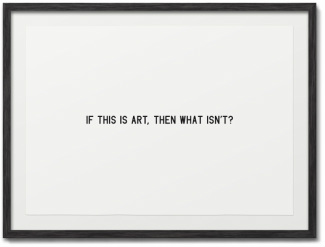 "Is This Art?" (fig 2: If This Is Art); ©Maciej Ratajski (artist) "Is This Art?" (fig 2: If This Is Art); ©Maciej Ratajski (artist) Tags: art/music, organizations/occupations/work, social construction, theory, art worlds, howard becker, networks, 00 to 05 mins Year: 2010 Length: 2:22 Access: YouTube Summary: This humorous video was recorded by Ken Tanaka during his visit to the Smithsonian American Art Museum in Washington, D.C. (Tanaka is an alter-ego of comedian and actor, David Ury). In this clip, Tanaka expresses his appreciation for what he believes is an installation piece called "Please Do Not Enter." The gallery guard is quick to correct Tanaka, informing him that, "This is not artwork" but rather the remnants of an exhibit that closed two days ago. But Tanaka presses on, articulating the ways in which this particular combination and composition of materials (a trash can, cardboard, and Styrofoam) speak to him: "I thought this was a good commentary on the disposable American society," he says. Eventually, a crowd starts to gather around the exhibit, and the gallery guard laughs saying, "You got everybody thinking it's art." To which Tanaka responds, "But it is art. Otherwise it wouldn't be in a museum." This clip can be used to illustrate Howard Becker's theory of art worlds. In his book by the same name, Becker (1982) argues that art worlds refer to "the network of people whose cooperative activity, organized via their joint knowledge of conventional means of doing things, produces the kind of art works that art world is noted for" (x). In short, this social organizational (rather than aesthetic) approach to art suggests that a network of people produce art and determine what art is. In this clip, Tanaka's artistic assessment of "Please Do Not Enter" is challenged, as the gallery guard is privy to the fact that the larger art world would not consider it art. Tanaka, of course, also draws upon an art world approach in his defense for why it must be art, "Otherwise it wouldn't be in a museum." Museums represent a segment of the network of people that make up an art world, and they lend institutional legitimacy to whether something is categorized as art or not. Notably, this video was shot in the American folk art wing of the museum. Created by artists without formal training, American folk art was overlooked by the larger art world for a long time. Once folk art began to receive attention from mainstream players in the art world, such as collectors, galleries, and eventually museums, the genre came to be defined as a valuable artistic expression, with some pieces now selling for over a $1 million. This video would also pair well with Ashley Mears' (2011) ethnographic study Pricing Beauty, in which she applies Becker's theory to the world of modeling, illustrating how a network of people come to determine what defines a good "look." Submitted By: Valerie Chepp
3 Comments
Manuel Franco
7/29/2023 02:50:52 am
I just want to say Thank You to everyone who supported me through the years. My name is Manuel Franco, New Berlin, Wisconsin. My story of how I won the Powerball lottery of $768.4M is a bit of a tale. I have been playing Powerball tickets for 6 years now since I turned 18. I bought my first ticket on my 18 birthday. I was feeling very lucky that day because I had contacted Dr. Odunga Michael to help me with the winning Powerball numbers. I really had that great great feeling that I looked at the camera wanting to wink at it. I only did a tiny part of it and trusted him. He gave me the numbers after I played a couple other tickets along with it for $10. I checked my ticket after the winnings came online and saw the numbers were correct including the Power play. I screamed for about 10 minutes because it felt like a dream. I had won $768.4M. You can check my winning testimony with the lottery officials just with my name search. Thank you Dr Odunga. Well, his email is [email protected] and you can also call or Whats-app him at +2348167159012 so you guys can contact him
Reply
mark hold
7/8/2024 12:06:43 am
Herbal Penis Enlargement product is 100% guaranteed to Enlarge and get a better ERECTION, the reason why most people are finding it difficult to enlarge Penis is that they believe in medical reports, drugs and medical treatment which is not helpful for Penis Enlargement. Natural roots/herbs are the best remedies which can easily Enlarge your Penis permanently Contact Dr MOSES BUBA via Email: [email protected] or via WhatsApp: +2349060529305. for Natural root and herbal remedies put together to help Enlarge manhood and Erect healthily. I also learn that Dr MOSES BUBA also can cure other types of diseases, HEPATITIS B,DIABETICS,CANCER,HPV,LOW SPERM CAM, HIV/STDS, FIBROSIS LOST OF WEIGHT, BREAST ENLARGEMENT, HIPS and BUMS ENLARGEMENT etc .
Reply
Leave a Reply. |
Tags
All
.
Got any videos?
Are you finding useful videos for your classes? Do you have good videos you use in your own classes? Please consider submitting your videos here and helping us build our database!
|
 RSS Feed
RSS Feed
